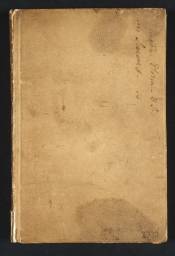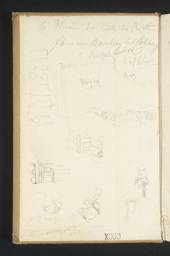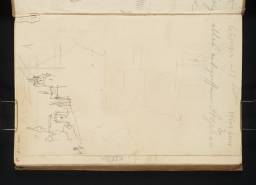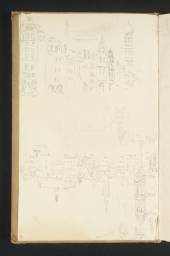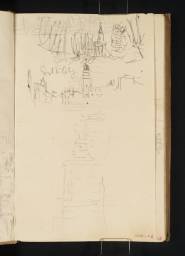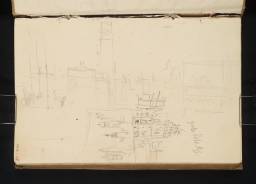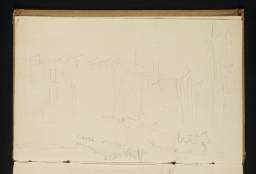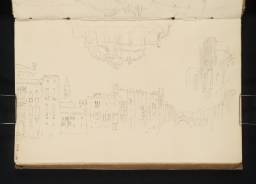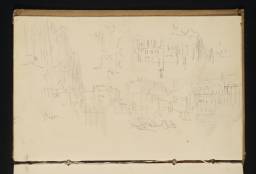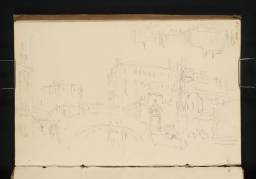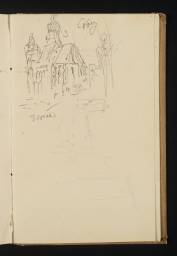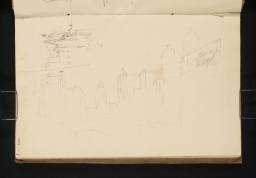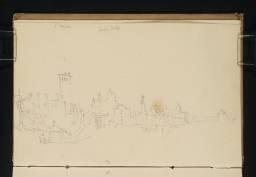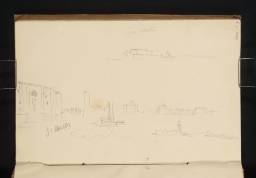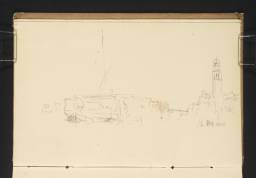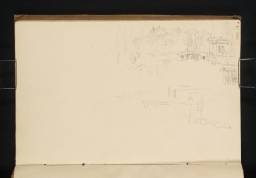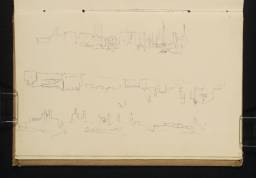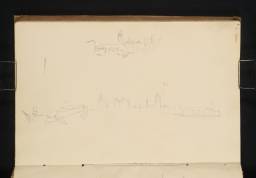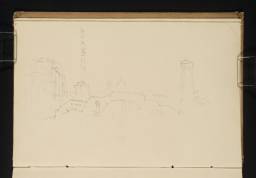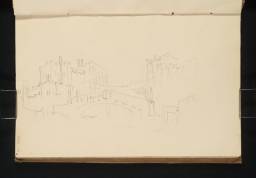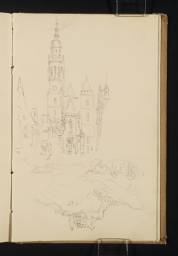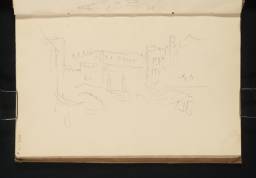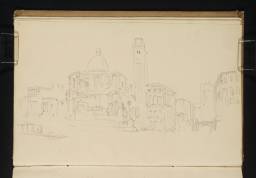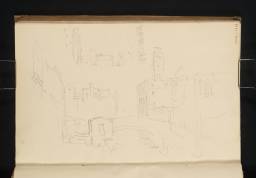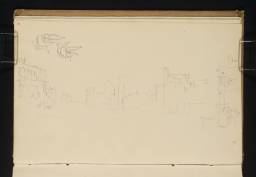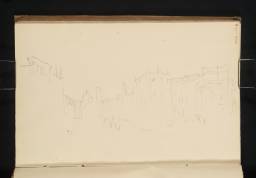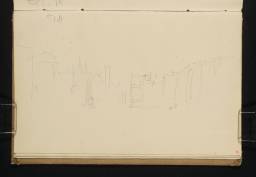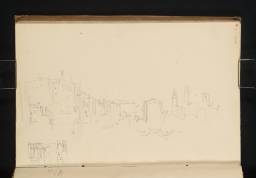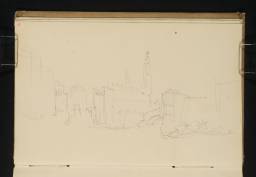Turner Bequest CCCX 1–70a
Sketchbook bound in boards, covered in buff wove paper, with single blind-ruled lines at outer edges; signs of anchoring points for ribbon ties inside back cover (D41401)
70 leaves of cream wove paper and paste-downs of white laid paper; page size 198 x 126 mm
Unidentified Austrian maker; various leaves watermarked partially with ‘J. Wha’ and correspondingly ‘atman’
Numbered 336 as part of the Turner Schedule in 1854 and endorsed by the Executors of the Turner Bequest inside back cover (D41401)
Stamped in black ‘CCCX’ on front cover (D41399)
Blind-stamped with Turner Bequest monogram, inscribed in pencil ‘CCCX’ and stamped in black ‘CCCX’ on back cover (D41402)
70 leaves of cream wove paper and paste-downs of white laid paper; page size 198 x 126 mm
Unidentified Austrian maker; various leaves watermarked partially with ‘J. Wha’ and correspondingly ‘atman’
Numbered 336 as part of the Turner Schedule in 1854 and endorsed by the Executors of the Turner Bequest inside back cover (D41401)
Stamped in black ‘CCCX’ on front cover (D41399)
Blind-stamped with Turner Bequest monogram, inscribed in pencil ‘CCCX’ and stamped in black ‘CCCX’ on back cover (D41402)
Accepted by the nation as part of the Turner Bequest 1856
Exhibition history
References
The majority of this sketchbook comprises part of Turner’s homeward route from Venice in September 1840, moving north-westwards through southern Germany between Passau, on the River Danube at its confluence with the Inn, and Würzburg on the Main, some 200 miles distant as the crow flies, albeit rather more on the ground, particularly with a diversion northwards to Coburg and the Itz Valley towards the end of this phase.1 Two key sites are the Walhalla, a temple-like monument to eminent Germans then nearing completion beside the Danube near Regensburg, and Schloss Rosenau, near Coburg, the birthplace of Prince Albert, who had become Prince Consort to Britain’s Queen Victoria earlier in the year. Turner would come to exhibit oil paintings depicting both sites, as discussed below.
Initially, however, the first quarter of the book as foliated was used for what were perhaps the last pencil drawings he made before leaving Venice (see the Introduction to the tour), following on from the later pages of the Rotterdam to Venice book and virtually all of Venice and Bozen (Tate; Turner Bequest CCCXX, CCCXIII); see folios 1 recto, 2 recto–10 recto, 11 recto–16 recto, 17 recto, and 18 recto, and a stray view on folio 57 recto (D31277, D31279–D31295, D31297–D31307, D31309–D31310, D31388). Some are too slight to identify specifically, but after a few views of largely familiar scenes around the Bacino and the Grand Canal, three short sequences emerge: around the western end of the Canale della Giudecca (D31288–D31293); the Cannaregio canal and northern reaches of the Grand Canal down to the Rialto Bridge (D31294–D31305, except D31296); and the Bridge of Sighs (D31306–D31310, except D31308; and D31388).
In his 1909 Turner Bequest Inventory, Finberg called this the ‘Coburg, Bamberg, and Venice Sketch Book’, partly from John Ruskin’s customary endorsement on a separate wrapper (since lost): ‘336. Book of Bamberg and Venice. Very careless. Some fine fortresses.’2 Turner labelled several individual drawings of Coburg, and a note of travel costs in a German hand inside the front cover (D41400) includes the phrase ‘von Bamberg bis Coburg’. Finberg dated the book to 1840 (albeit at first cautiously suffixing an asterisk to indicate uncertainty);3 this was on the evidence of a sketch (folio 22 recto; D31318),4 related to Turner’s 1841 painting of Rosenau in combination with the artist’s unusually specific note, ‘Coburg | Sunday 20 Sept’, on folio 62 recto (D31398). As Finberg observed: ‘The 20th September, 1840, fell on a Sunday.’5
Returning to Turner’s Venetian work in 1930, Finberg dated the book unreservedly to 1840, and observed:
This should be called “Venice, Bamberg and Coburg Sketch Book,” as it was used on the return journey. I have not recognized any sketches in the Trentino (there is one of Bolzano in cccxiii [the Venice and Bozen sketchbook]) nor at Innsbruck or Munich, but there are several at Ratisbon [Regensburg], Bamberg, Coburg and Rosenau.6
Though he was largely correct in terms of the range of sketchbooks he then linked with the 1840, he was assuming Turner travelled directly north from Venice towards Germany, with this sketchbook at hand. It has since been established, as set out in the Introduction to this tour, that there was a long interval between its use in Venice and from Passau onwards, while the Trieste, Graz and Danube sketchbook (originally ‘Danube and Graz’; Tate; Turner Bequest CCXCIX) was used on the roundabout eastwards-northwards-westwards route embodied in its modern title. As set out in its Introduction, Turner had left Venice on 3 September, was in Vienna on the 7th, and was near Linz, east of Passau, three days later. (This was well away from Bolzano, now in northern Italy, where Turner had stayed on the outward journey; see under Tate D31922; Turner Bequest CCCXIII 67).
The Trieste, Graz and Danube sketchbook filled in the ‘missing links’ in the return journey, as Hardy George put it in 1971, while echoing Finberg in suggesting that the present book ‘perhaps should be titled “Venice to Bamberg”’;7 it acquired its current two-part name, incorporating Passau, in relation to Cecilia Powell’s 1995 Turner in Germany exhibition, which established the full route.8 George remarked on the ‘disordered arrangement’ of the ‘somewhat jumbled’ sketches,9 and general sequence of the non-Venetian subjects is in reverse of the foliation, as he and Powell have observed.10 Turner presumably began them from the ‘back’ with the practical intention of keeping the two phases distinct. The order of the leaves is undisturbed but, apparently lacking a new sketchbook, Turner ended up using spare pages somewhat randomly, added Bamberg and Coburg views among earlier ones of Hals (near Passau), and even interpolating Coburg scenes within empty Venetian skies and foregrounds.
The last of the Trieste, Graz and Danube sketches had been made at Passau, the first German city Turner reached as he disembarked from his Austrian Danube voyage from Vienna. He continued his thorough survey here (see under folio 48 verso; D31371), as well as exploring Hals and its dramatically sited castle ruins above the meandering River Ilz (see under folio 58 verso; D31391).11 The city, impressively situated at the meeting of the Danube and Inn with the modest Ilz, was new to Turner,12 as were all of the places he encountered here except Nuremberg (see below). As noted under D31371, Turner’s exploration of Passau led to one finished watercolour, Passau, Germany, at the Confluence of the Rivers Inn and Danube (National Gallery of Ireland, Dublin),13 evoking his arrival by steamer.
Powell has suggested that the artist continued ‘by road, possibly at night’,14 and there is only one small sketch of Vilshofen, upriver about fifteen miles to the west (folio 50 recto; D31374), before Turner reached Regensburg (then often known to English-speakers as Ratisbon), sixty miles or so further on, at the confluence of the Regen with the Danube; see under folio 18 verso (D31311). He stayed at the Drie Helmen (Three Helms) hotel in the Neupfarrplatz, as reported in the Regensburger Zeitung of Monday 14 September, close to the cathedral and the long medieval Steinerne Brücke spanning the islet-strewn channels of the Danube.15 From there he made his way east about five miles downstream to Donaustauf, to see the Parthenon-like Walhalla, in the late stages of its construction above the town; see under folio 33 verso (D31341). It was inaugurated two years later, and Turner exhibited a major painting of The Opening of the Wallhalla [sic], 1842 (Tate N00533)16 at the Royal Academy in 1843 and again (to a disappointing reception) at the Munich ‘Congress of European Art’ in 1845.17
Despite a contemporary lack of British appreciation for the historic architecture of Regensburg, perceived as gloomy and oppressive, he found enough of interest in its setting to make several separate grey paper studies of the city and the Walhalla views in pencil, chalk and watercolour (as detailed under D31311 and D31341), gathered here in the parallel subsection of sheets relating to the return journey from Venice. Since the emergence and identification of an unfinished watercolour on white paper showing the Thurn and Taxis Palace in the city (private collection; see under folio 40 verso; D31355),18 Ian Warrell has grouped it thematically with three others of the same size (potentially as quarters of an original sheet), which he characterised as ‘just as revelatory’ as Turner’s 1840 Venice and late Swiss watercolours:19 a dramatic nocturnal subject traditionally known as ‘A conflagration, Lausanne’ but now recognised as showing Regensburg from the Drie Helmen, by the lurid light of a documented fire which he likely witnessed in the early hours of 13 September or heard of shortly afterwards (Whitworth Art Gallery, Manchester; see under folio 41 verso; D31357);20 another (previously called ‘Lyons’; Victoria and Albert Museum, London; see under folio 42 verso; D31359)21 with a sunset view of the cathedral across the Danube; and an ethereal ‘colour beginning’ of the Walhalla (Tate D36174; Turner Bequest CCCLXIV 316).
From Regensburg it was about another sixty miles to Nuremberg (see under folio 29 recto; D31332),22 where Turner did not make many sketches this time, having surveyed it extensively in 1835 on the homeward leg of his tour through Denmark, Berlin and Prague. From there he turned northwards about thirty miles or so to Bamberg; see under folio 19 recto (D31312). Powell has noted that he travelled ‘almost certainly on the Eilwagen which was advertised as arriving from Nuremberg at 8 p.m. on Wednesday 16 September’,23 and was recorded that night at the Drei Kronen (Three Crowns) hotel in Langegasse in the next day’s edition of the local Tagblatt der Stadt Bamberg.24
Although he made numerous drawings of Bamberg’s medieval buildings and church spires both from within the city and from the heights at the nearby Altenburg,25 he did not linger there long either, pushing on to Coburg, around twenty-five miles north again (see under folio 1 verso; D31278). There are two roughly parallel roads, and Turner may have taken one there and the other back. The eastern follows the course of the River Main,26 and there are views along that route at Ebing (folio 44 verso; D31363) and of hills likely around Lichtenfels or nearby Bad Staffelstein (folio 32 recto; D31338). The western follows the smaller River Itz, and there seems to be a labelled view of Poppendorf, near the river north of Rattelsdorf (folio 63 recto; D31400). See also a slight sketch of the neighbouring hilltop Giechburg and Gügel, near the River Main around Schesslitz, a few miles north-east of Bamberg (folio 29 recto; D31332).
Then capital of the Duchy of Saxe-Coburg-Gotha, Coburg and its vicinity occupied several days: two sketches are dated 17 September (folios 1 recto, 60 recto; D30002, D30115), and another (folio 62 recto; D30119), ‘Coburg | Sunday 20 Sept’, as Finberg had noted.27 Turner’s stay at the Weisser Schwan hotel in Spitalgasse has been inferred by Powell from his sketches; see folios 1 recto and verso (D30002–D30003).28 There are numerous views of the town, including the imposing Schloss Ehrenburg palace, and its verdant surroundings, with the medieval hilltop Veste Coburg fortress in parkland to its east and Schloss Ernsthöhe, a modern country house to its west.29
Turner ventured further afield to Schloss Rosenau, in countryside beside the Itz about four miles north-east of the town; see under folio 22 recto (D31318). He made a number of sketches of this relatively modest house and its elevated setting among trees above the river, which informed his large oil painting of Schloss Rosenau, Seat of H.R.H. Prince Albert of Coburg, near Coburg, Germany, exhibited at the Royal Academy in 1841 (Walker Art Gallery, Liverpool).30 That Coburg and Rosenau involved a detour, albeit a relatively minor one, suggests the artist had already considered such a subject, although if he had hoped for royal patronage he was to be disappointed.31
There are no more identified views from the subsequent journey by road until two small, scattered sketches of the towers of Dettelbach on the River Main, on folios 51 recto and 68 verso (D31376, D31411),32 over thirty miles west of Bamberg and some ten east of Würzburg. He may have had his only previous glimpse of that city in 1835, while travelling past in the rain from Nuremberg to Frankfurt; see the Prague, Nuremberg, Frankfurt and Rhine sketchbook (Tate D30719; Turner Bequest CCCIV 47). Bamberg, Coburg and Würzburg feature in a rough sketch map of the course of the Main inside the front cover here (D41400).
Powell has noted Würzburg as the ‘last German city Turner explored in 1840’; he was recorded in the Neue Würzburger Zeitung of 23 September at the central Wittelsbacher Hof.33 He squeezed in a single view from the hotel (folio 51 recto; D31376) before starting afresh with a long series of studies in the Würzburg, Rhine and Ostend sketchbook (see under Tate D30596; Turner Bequest CCCIII 71), which then lasted him for the rest of the tour before arriving back in London in early October.
Finally, as a relief from topography, there are scattered studies of local German women and their costumes on folios 67 verso, 69 recto, 70 recto and verso and the insides of the front and back covers (D31409, D31412, D31414–D31415, D41400–D41401), a group of figures possibly copied from a painting (folio 45 recto; D31464) and, for good measure, an unsensational erotic study (folio 65 recto; D31404).
Not in Wilton 1979; Warrell 2015, p.5 fig.4 (colour), as ‘The Thurn und Taxis Palace, with the Obermunster in the Distance, Regensburg’, c.1840.
Wilton 1979, p.474 no.1455, reproduced; Warrell 2015, p.4 fig.2, as ‘Regensburg: the Neupfarrplatz at Night, with a Nearby Fire’, c.1840.
Wilton 1979, p.487 no.1555, pl.256; Warrell 2015, p.6 fig.5, as ‘Regensburg from the Danube, with the Cathedral and Stone Bridge, at Sunset, c.1840.
Technical notes
How to cite
Matthew Imms, ‘Venice; Passau to Würzburg Sketchbook 1840’, sketchbook, September 2018, in David Blayney Brown (ed.), J.M.W. Turner: Sketchbooks, Drawings and Watercolours, Tate Research Publication, December 2019, https://www

